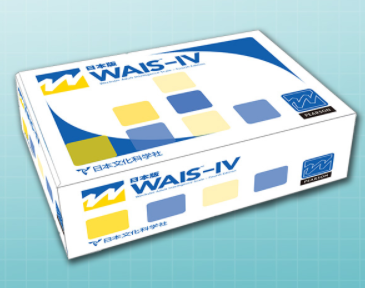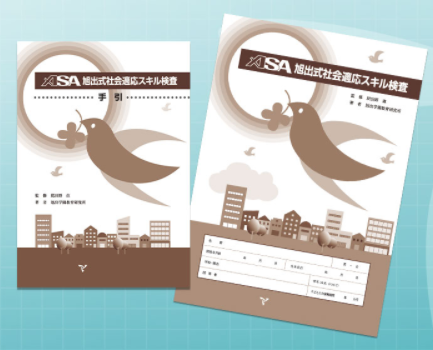RESEARCH PROJECTS
My general interests are developing and applying statistical methods for behavioral science (educational, psychological and medical research) using
latent variable modeling approach. Methodologically, I am particularly focused on methods in longitudinal data analysis (latent growth model and
cross-lagged panel models), structural equation modeling (SEM), and multilevel/mixed-effects model.
Research keywords: longitudinal data analysis, structural equation modeling, item response theory, multilevel model, mixed-effects model,
latent growth model, cross-lagged panel models, causal inference, model selection, recursive partitioning, decision tree, sample size determination,
experimental design, statistical power, psychological scaling, Bayesian data analysis, computational statistics,
educational measurement, essay test, development of educational, psychological, medical and clinical tests.
1, Longitudinal data analysis
2, Research design for research that uses mixed-effects model
3, Measurement issues in essay type test
4, Item response model
5, Statistical methods and applications for behavioral science
6, Development of clinical and psychological tests

Methodogical issues for investigating reciprocal relation and causality for longitudinally observed variables. Especially, (i)
developing unified framework to clarify the conceptual and mathematical similarity and difference of existing longitudinal models
to examine reciprocal relation, and (ii) developing statistical methods to disentangle within-person processes from stable individual differences.
Latent growth model and mixed effects model to desribe the pattern of changes/developmental trajectories and its group/individual differences.
Especially, (i)developing a growth curve model that appropriately incorporates time-specific errors, which influence all participants at each time point,
and (ii) the issues of model selection and classification accuracy in applying latent growth mixture model
and structural equation model trees (SEM Trees) to uncover group differences in changes.
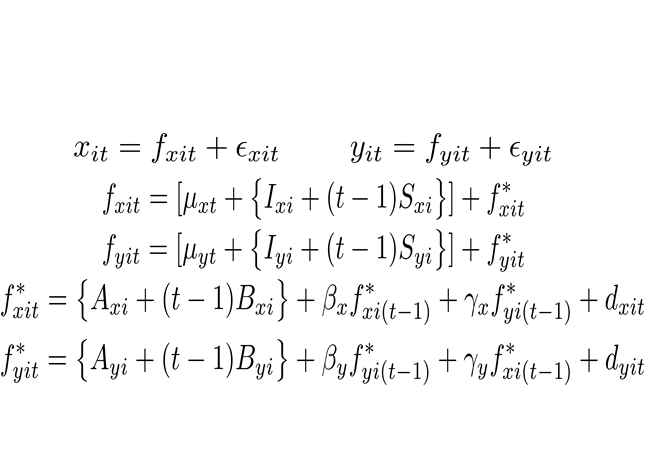
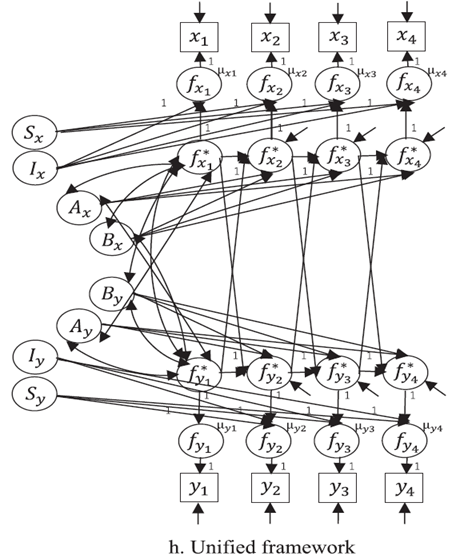
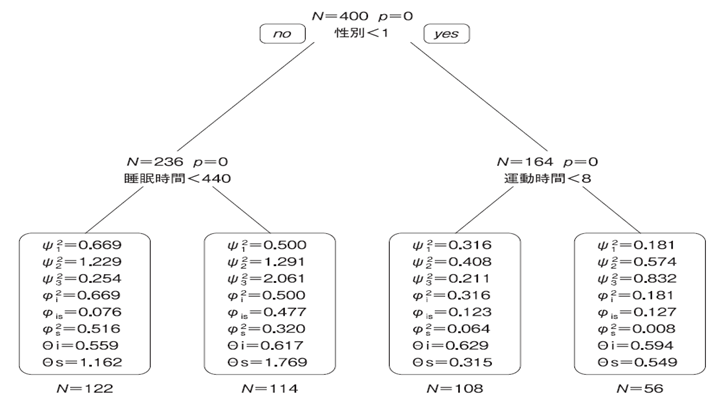
Unified framework of longitudinal models and path diagrams Analysis example of SEM Trees
to examine reciprocal relations (Usami, Murayama & Hamaker, 2019)
Major achievements
Usami,S. (2023). Within-person variability score-based causal inference: A two-step estimation for joint effects of time-varying treatments. Psychometrika, 88(4), 1466-1494. [Paper]
Usami,S. (2021). On the differences between general cross-lagged panel model and random-intercept cross-lagged panel model: Interpretation of cross-lagged parameters and model choice. Structural Equation Modeling, 28, 331-344. [Paper]
Usami,S., Murayama,K., & Hamaker,E.L. (2019). A unified framework of longitudinal models to examine reciprocal relations. Psychological Methods, 24(5), 637-657.[Paper]
Usami,S., Jacobucci,R., & Hayes,T. (2019). Performance of latent growth model based structural equation model trees to uncover population heterogeneity in growth trajectories. Computational Statistics, 34(1), 1-22.[Paper]
Usami,S., & Murayama,K. (2018). Time-specific errors in growth curve modeling: Type-1 error inflation and a possible solution with mixed-effects models. Multivariate Behavioral Research, 53, 876-897.[Paper] [OSM]
Usami,S., Hayes,T., & McArdle,J.J. (2017). Fitting structural equation model trees and latent growth curve mixture models in longitudinal designs: The influence of model misspecification in estimating the number of classes. Structural Equation Modeling. 24, 585-598.
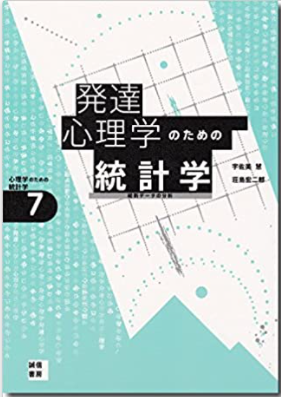
Usami,S., Hayes,T., & McArdle,J.J. (2015). Inferring longitudinal relationships between variables: model selection between the latent change score and autoregressive cross-lagged factor models. Structural Equation Modeling, 23, 331-342.
Usami,S., Hayes,T., & McArdle,J.J. (2015). On the mathematical relationship between latent change score model and autoregressive cross-lagged factor approaches: Cautions for inferring causal relationship between variables. Multivariate Behavioral Research, 50, 676-687.
Usami,S. & Shojima, K. (2015). Statistical methods for developmental psychology -longitudinal data analysis- (in Japanese) Seishin-Shobo.

We are interested in deveoping easy and useful methods (mathematical formulas, numerical tables and softwares) to evaluate the required numbers of the sample sizes
(individual and group sizes) for hierarchical data, which often appears in behavioral research. We are also investigating the issue of model misspecification and resulting (inflated) type-1 errors
in mixed-effects modeling.
Major achievements
Murayama,K., Usami,S., & Sakaki,M. (2022). Summary-statistics-based power analysis: A new and practical method to determine sample size for mixed-effects modelling. Psychological Methods, 27(6), 1014-1038.[Preprint]
Usami,S. (2020). Confidence interval-based sample size determination and some mathematical properties for hierarchical data. British Journal of Mathematical and Statistical Psychology, 73, 1-31.[Preprint]
Usami,S., & Murayama,K. (2018). Time-specific errors in growth curve modeling: Type-1 error inflation and a possible solution with mixed-effects models. Multivariate Behavioral Research, 53, 876-897.[Paper] [OSM]
Usami,S., (2016). Generalized sample size determination formulas for investigating contextual effects by a three-level random intercept model. Psychometrika, 82, 133-157.
Usami,S. (2014). A convenient method and numerical tables for sample size determination in longitudinal-experimental research using multilevel models. Behavior Research Methods. 46, 1207-1219.
Usami,S. (2013). Generalized sample size determination formulas for experimental research with hierarchical data. Behavior Research Methods. 46, 346-356.

Although most of works are published in Japanese, we have been investigating measurement issues (e.g., reliability and validity)
for essay-type test, especially in the context of university entrance examinations. With emphasis on statistical and analytical aspects
(such as factor analyses and generalizability theory), we gather and analyze essay test data to suggest more effective test design.
Major achievements
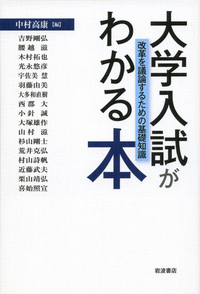
Usami,S. (2020). Essay-type question from the view of test theory. Nakamura, T (ed). A guidebook for university entrance examination. (In Japanese) Iwanami Publishing Co.
Usami,S. (2013). Measurement problems and their treatments in essay-type tests. The Japanese Journal for Research on Testing, 9, 145-164. (In Japanese)[paper]
Usami,S. (2011). Statistical analysis of essay test data - Investigation of measurement problems by controlling length of essays- Japanese Journal of Behaviormetrics, 38, 33-50. (In Japanese)[paper]
Usami,S. (2010). Polytomous item response model that considers bias factors about raters and examinees simultaneously -Estimation through MCMC algorithm- Japanese Journal of Educational Psychology, 58, 163-175. (In Japanese)[paper]
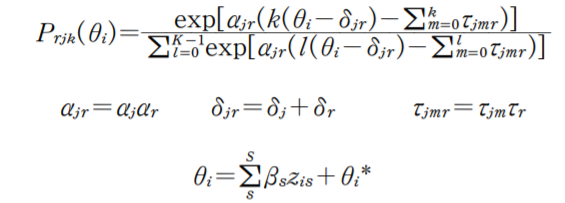
Item response theory (IRT) model is also an our central research topic. We have proposed a new item response model for analyzing essay test data when multiple (human) raters exist.
We are also interested in investigating IRT models for a pairwise preference-based personality test that is expected to be resistant to faking effect (e.g., social desirability).
Major achievements
Usami,S., Sakamoto,A., Naito,J., & Abe,Y. (2016). Developing pairwise preference based personality test and experimental investigation of its resistance to faking effect by item response model. International Journal of Testing. 16, 288-309.
Usami,S. (2010). Polytomous item response model that considers bias factors about raters and examinees simultaneously -Estimation through MCMC algorithm- Japanese Journal of Educational Psychology, 58, 163-175. (In Japanese)[paper]

As a quantitative expert, We are collaborating with substantive researchers on a number of topics relating to educational, psychological and medical research.
Our role is to support and enhance the evidence level of their research outputs published in bevarioral science. We often use latent variable modeling approach
such as item response model, structural equation modeling and multilevel model/mixed effects model to analyze and understand data.
Major achievements
Uno,A., Nagaoka,D., Usami,S., Yamaguchi,S., Minami,R., Tanaka,R., Sawai,Y., Okuma,A., Yamasaki,S., Miyashita,M., Nishida,A., Kasai,K., & Ando,S. (in press). Suicidal thoughts and trajectories of psychopathological and behavioral symptoms in adolescence. JAMA network open, 7(1), e2353166-e2353166.
Nagaoka,D., Uno,A., Usami,S., Tanaka,R., Minami,R., Sawai,Y., Okuma,A., Yamasaki,S., Miyashita,M., Nishida,A., Kasai,K., & Ando,S. (in press). Identify adolescents' help-seeking intention on suicide through self- and caregiver's assessments of psychobehavioral problems: deep clustering of the Tokyo TEEN Cohort study. The Lancet Regional Health–Western Pacific, 43
Narita,Z., DeVylder,J., Yamasaki,S., Ando,S., Endo,K., Miyashita,M., Yamaguchi,S., Usami,S., Stanyon,D., Knowles,G., Hiraiwa-Hasegawa,M., Furukawa,T.A., Kasai,K, & Nishida,A. (2024). Uncovering associations between gender nonconformity, psychosocial factors, and mental health in adolescents: a birth cohort study. Psychological medicine, 54(5), 921-930.
Aihara,M., Jinnouchi,H., Yoshida,A, Ijima,H., Sakurai,Y., Hayashi,T., Koizumi,C., Kubota,T., Usami,S., Yamauchi,T., Sakata,T., Kadowaki,T., & Kubota,N. (2023). Evaluation of glycated albumin levels in tears and saliva as a marker in patients with diabetes mellitus. Diabetes Research and Clinical Practice, 199. 110637.
Ando,S., Suzuki,H., Matsukawa,T., Usami,S., Muramatsu,H., Fukunaga,T., Yokoyama,K., Okazaki,Y., & Nishida,A. (2022). Comparison of lithium levels between suicide and non-suicide fatalities: cross-sectional study. Translational Psychiatry, 12:466.
Hosozawa,M., Cable,N., Yamasaki,S., Ando,S., Endo,K., Usami,S., Nakanishi,M., Niimura,J., Nakajima,N., Baba,K., Oikawa,N., Stanyon,D., Suzuki,K., Miyashita,M., Iso,H., Hiraiwa-Hasegawa,M., Kasai,K., Nishida,A. (2022). Predictors of chronic loneliness during adolescence: a population-based cohort study. Child and Adolescent Psychiatry and Mental Health, 16(1), 1-9.
Nakanishi,M., Shibasaki,R., Yamasaki,S., Miyazawa,S., Usami,S., Nishiura,H., Nishida, A.(2021). COVID-19 and on-site dining in Tokyo: A time-series analysis using mobile phone location data. JMIR mHealth and uHealth, 9(5), e27342.
He,H., Usami,S., Rikimaru,Y., & Jiang,L. (2021). Cultural roots of parenting: mothers’parental social cognitions and practices from Western US and Shanghai/China. Frontiers in Psychology.
Sugimoto,A., Ono,S., Usami,S., Nitta,T., & Ogawa,R. (in press). Older patients and patients with severe arteriosclerosis are less likely to develop keloids and hypertrophic scars after thoracic midline incision: A survey-based analysis of 328 cases. Plastic and Reconstructive Surgery.
Aihara,M., Kubota,N., Minami,T., Shirakawa,R., Sakurai,Y., Hayashi,T., Iwamoto,M., Takamoto,I., Kubota,T., Suzuki,R., Usami,S., Jinnouchi,H., Aihara,M., Yamauchi,T., Sakata,T., & Kadowaki,T. (2021). Association between tear and blood glucose concentrations: random intercept model adjusted with confounders in tear samples negative for occult blood. Journal of Diabetes Investigation, 12, 266-276.
Yamaguchi,S., Ojio,Y., Foo,J.C., Michigami,E., Usami,S., Fuyama,T., Ohnuma,K., Oshima,N., Ando, S., Togo, F., & Sasaki, T., (2020). A quasi-cluster randomized controlled trial of a classroom-based mental health literacy educational intervention to promote knowledge and help-seeking/helping behavior in adolescents. Journal of Adolescence, 82, 58-66.
Ando,S., Nishida,A., Yamasaki,S., Koike,S., Morimoto,Y., Hoshino,A., Kanata,S., Fujikawa,S., Endo,K., Usami,S., Furukawa,T.A., Hiraiwa-Hasegawa,M., Kasai,K. (2019). Cohort profile: Tokyo Teen Cohort study (TTC). International Journal of Epidemiology, 48, 1414-1414g
Yamasaki,S., Ando,S., Richards,M., Hatch,S.L., Koike,S., Fujikawa,S., Kanata,S., Endo,K., Morimoto,Y., Arai,M., Okado,H., Usami,S., Furukawa,T.A, Hiraiwa-Hasegawa,M, Kasai,K., & Nishida,A. (2019). Maternal diabetes in early pregnancy, and psychotic experiences and depressive symptoms in 10-year-old offspring: a population-based birth cohort study. Schizophrenia Research, 206, 52-57.
Ando,S., Nishida,A., Usami,S., Koike,S., Yamasaki,S., Kanata,S., Fujikawa,S. Furukawa,T.A, Fukuda,A., Sawyer,S., Hiraiwa-Hasegawa,M., & Kasai,K. (2018). Help-seeking intention for depression in early adolescents: associated factors and sex difference. Journal of Affective Disorders. 238, 359-365.
Itokawa,M., Miyashita,M., Arai,M., Dan,T., Takahashi,K., Tokunaga,T., Ishimoto,K., Toriumi,K., Ichikawa,T., Horiuchi,Y., Kobori,A., Usami,S., Yoshikawa,T., Amano,N., Washizuka,S., Okazaki,Y., & Miyata,T. (2018). Pyridoxamine, a novel treatment for schizophrenia with enhanced carbonyl stress. Psychiatry and Clinical Neurosciences, 72, 35-44.
Yamasaki,S., Usami,S., Sasaki,R., Koike,S., Ando,S., Kitagawa,Y., Matamura,M., Fukushima,M., Yonehara,H., Foo,J.C., Nishida, A., & Sasaki, T., (2018). The association between changes in depression/anxiety and trajectories of psychotic-like experiences over a year in adolescence. Schizophrenia Research. 195, 149-153.
Kakei,Y., Akashi,M., Hasegawa,T., Minamikawa,T., Usami,S., & Komori,T. (2016). Incidence of venous thromboembolism after oral oncologic surgery with simultaneous reconstruction. Journal of Oral and Maxillofacial Surgery. 74, 212-217.

(Classical) Test theory provides basic concepts (reliability and validity) and ways to enhance the outcomes of psychological testing from measurement points of view.
We are interesting in developing standardized psychological and clinical tests using the concept of the test theory.
Major achievements
Publication Committee of Japanese version of the Wechsler Adult Intelligence Scale-IV (2018). Japanese version of the Wechsler Adult Intelligence Scale-IV Manual. Nihon Bunka Kagakusha Co., Ltd.
Usami, S. (2016). Revision process of the test/Reliability and validity of the test. In Ueno, K., Nagoshi, N., & Asahide Research Institute for Mentally retarded. S-M social ability test (3rd ed). Nihon Bunka Kagakusha Co., Ltd.
Usami, S. (2013). Validity and Reliability of FOSCOM. In Tohkawa, T., Usami, S., Ui, M., Kajinawa, H., Komori, K., & Tanaka, R. Format of observation for social communication (FOSCOM) Escor Co.
Usami, S. (2013). Reliability and validity of the test. In Satake, T., Adachi, A., Ikeda, Y., & Usami, S. HIRAGANA test for children based on sign-significate relations (HITSS) Escor Co.
Usami, S. (2012). Making process of Asahide-Social Adaptive Skills Test. In Hidano, T. ed, Asahide Research Institute for Mentally retarded (2012). ASA Asahide-Social Adaptive Skills Test. Nihon Bunka Kagakusha Co., Ltd.
